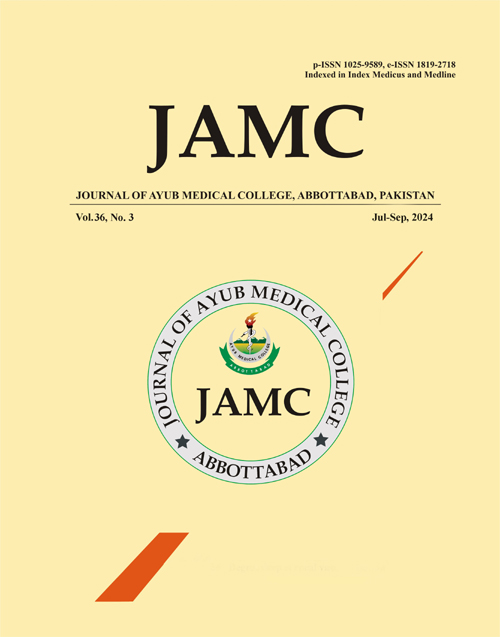A CROSS-SECTIONAL STUDY ON CARPAL TUNNEL SYNDROME AMONG PREGNANT WOMEN
DOI:
https://doi.org/10.55519/JAMC-03-12717Keywords:
Carpel Tunnel Syndrome, Pregnancy, Trimester, FrequencyAbstract
Background: Carpal tunnel syndrome (CTS) is triggered by compression of the median nerve as it passes through the carpal tunnel. The main cause of CTS is the raised pressure inside the carpal tunnel. The common early symptoms of CTS consist of discomfort, numbness, and paresthesia’s that particularly impact the first three digits and the outermost portion of the fourth digit Objective: To evaluate the frequency of carpel tunnel syndrome in pregnant women. Methodology: A crosssectional study was carried on 165 pregnant patients presenting with wrist pain from November 2023 to May 2024. We determined the frequency of carpel tunnel syndrome in these patients. Results: Mean age of 165 patients was 28.28±5.94 years. Carpel tunnel syndrome was diagnosed in 59 (35.8%) patients. CTS was higher in patients in their third trimester 39 (66.1%), the association between CTS and trimester was notable (P = 0.0001). Conclusion: We conclude that 35.8% patients in this study were suffering from carpel tunnel syndrome while majority were in their third trimester
References
1. Genova A, Dix O, Saefan A, Thakur M, Hassan A. Carpal Tunnel
Syndrome: A Review of Literature. Cureus. 2020;12(3):e7333.
2. Osiak K, Elnazir P, Walocha JA, Pasternak AJ. Carpal tunnel
syndrome: state-of-the-art review. Folia Morphol.
2022;81(4):851-62.
3. Padua L, Cuccagna C, Giovannini S, Coraci D, Pelosi L, Loreti C,
et al. Carpal tunnel syndrome: updated evidence and new
questions. Lancet Neurol. 2023;22(3):255-67.
4. Wright AR, Atkinson RE. Carpal tunnel syndrome: An update for
the primary care physician. Hawaii J Health Soc Welf. 2019;78(11
Suppl 2):6-10.
5. Atroshi I, Gummesson C, Johnsson R, Ornstein E, Ranstam J,
Rosén I. Prevalence of carpal tunnel syndrome in a general
population. J Am Med Assoc. 1999;282(2):153-8.
6. Jackson R, Beckman J, Frederick M, Musolin K, Harrison R.
Rates of Carpal Tunnel Syndrome in a State Workers'
Compensation Information System, by Industry and Occupation -
California, 2007-2014. Morb Mortal Wkly Rep.
2018;67(39):1094-7.
7. Shiri R, Pourmemari MH, Falah-Hassani K, Viikari-Juntura E.
The effect of excess body mass on the risk of carpal tunnel
syndrome: a meta-analysis of 58 studies. Obes Rev.
2015;16(12):1094-104.
8. Oliveira GA, Bernardes JM, Santos ED, Dias A. Carpal tunnel
syndrome during the third trimester of pregnancy: prevalence and
risk factors. Arch Obstet Gynecol. 2019;300:623-31.
9. Ablove RH, Ablove TS. Prevalence of carpal tunnel syndrome in
pregnant women. Wis Med J.2009;108(4):194-6.
10. Zyluk A. Carpal tunnel syndrome in pregnancy: a review. Polish
Orthop Traumatol. 2013;78:223-7.
11. Ozturk AA, Erpala F. Pregnancy-related carpal tunnel syndrome;
non-invasive early diagnosis and post-partum evaluation. Med.
Sci. 2023;12:70-5.
12. Seror P. Conduction blocks of the median nerve at the wrist in
pregnancy and postpartum carpal tunnel syndromes. Muscle
Nerve. 2023;68(4):380-7.
13. Yazdanpanah P, Aramesh S, Mousavizadeh A, Ghaffari P,
Khosravi Z, Khademi A. Prevalence and severity of carpal tunnel
syndrome in women. Iran J Public Health 2012; 41(2):105-10.
14. Bukhari SR, Naz K, Ahmed Z, Rashid A, Ayaz S, Khan AU, et al.
Carpal Tunnel Syndrome and Its Prevalence in Pregnant Females
of Faisalabad Pakistan. Pak J Med Biol Sci 2018; 2(1):10-9.
15. Osterman M, Ilyas AM, Matzon JL. Carpal tunnel syndrome in
pregnancy. Orthop Clin North Am. 2012;43(4):515–520.
16. Baumann F, Karlikaya G, Yuksel G, Citci B, Kose G, Tireli H.
The subclinical incidence of CTS in pregnancy: assessment of
median nerve impairment in asymptomatic pregnant women.
Neurol Neurophysiol Neurosci. 2007;2;2.
17. Padua L, Di Pasquale A, Pazzaglia C, Liotta GA, Librante A,
Mondelli M. Systematic review of pregnancy-related carpal tunnel
syndrome. Muscle Nerve. 2010;42(5):697–702.
18. Meems M, Truijens S, Spek V, Visser LH, Pop VJ. Prevalence,
course and determinants of carpal tunnel syndrome symptoms
during pregnancy: a prospective study. BJOG. 2015;122(8):1112–
1118.
19. Khan R, Shafi P, Khan K, Ahmad T, Asad M. The Prevalence and
Severity of Carpel Tunnel Syndrome during Pregnancy. 2021;15
(7):2282-2284.
20. Waris M, Arshad N, Naz A, Shabbir M, Hanif M, Rehman M.
Carpal Tunnel Syndrome in Pregnant Women: A Cross Sectional
Study. Pak J Med Res. 2021;60(4):178-82
Downloads
Published
How to Cite
Issue
Section
License
Copyright (c) 2024 Tehsina Ali, M. Nawaz Khan, Mudassir Shah, Riaz ul Iqbal

This work is licensed under a Creative Commons Attribution-NoDerivatives 4.0 International License.
Journal of Ayub Medical College, Abbottabad is an OPEN ACCESS JOURNAL which means that all content is FREELY available without charge to all users whether registered with the journal or not. The work published by J Ayub Med Coll Abbottabad is licensed and distributed under the creative commons License CC BY ND Attribution-NoDerivs. Material printed in this journal is OPEN to access, and are FREE for use in academic and research work with proper citation. J Ayub Med Coll Abbottabad accepts only original material for publication with the understanding that except for abstracts, no part of the data has been published or will be submitted for publication elsewhere before appearing in J Ayub Med Coll Abbottabad. The Editorial Board of J Ayub Med Coll Abbottabad makes every effort to ensure the accuracy and authenticity of material printed in J Ayub Med Coll Abbottabad. However, conclusions and statements expressed are views of the authors and do not reflect the opinion/policy of J Ayub Med Coll Abbottabad or the Editorial Board.
USERS are allowed to read, download, copy, distribute, print, search, or link to the full texts of the articles, or use them for any other lawful purpose, without asking prior permission from the publisher or the author. This is in accordance with the BOAI definition of open access.
AUTHORS retain the rights of free downloading/unlimited e-print of full text and sharing/disseminating the article without any restriction, by any means including twitter, scholarly collaboration networks such as ResearchGate, Academia.eu, and social media sites such as Twitter, LinkedIn, Google Scholar and any other professional or academic networking site.










